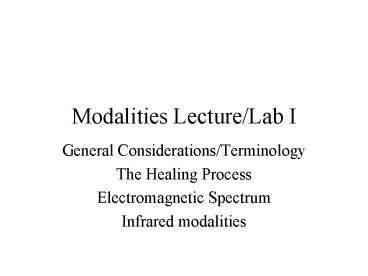Modalities LectureLab I - PowerPoint PPT Presentation
1 / 28
Title:
Modalities LectureLab I
Description:
What you need to know about each modality. Physiologic effect. Physics of the unit. Indications ... Health, Age, Nutrition. Humidity, Climate, O2 tension ... – PowerPoint PPT presentation
Number of Views:32
Avg rating:3.0/5.0
Title: Modalities LectureLab I
1
Modalities Lecture/Lab I
- General Considerations/Terminology
- The Healing Process
- Electromagnetic Spectrum
- Infrared modalities
2
Introduction
- What are modalities?
- What are they used for?
3
What you need to know about each modality
- Physiologic effect
- Physics of the unit
- Indications
- Precautions
- Contraindications
- Practical application
4
Healing Process
- Three Phases
- 1. Inflammatory
- 2. Fibroplastic/Proliferative
- 3. Maturation/Remodeling
5
Inflammatory Response Phase
- Injury? Destruction of tissue? Cellular injury.
- Cardinal Signs of Cellular injury redness,
edema, tenderness (pain), increased temperature. - There is a delivery of leukocytes and other
phagocytes and exudate are present at the injured
tissue. - Vascular Reaction involves vascular spasm,
formation of a platelet plug, coagulation
growth of fibrous tissue
6
Clot formation
- To form a clot fibrinogen must be converted to
fibrin - Clot formation begins around 12 hours following
injury and is completed by 48 hours - Summaryduring the inflammatory stage the injured
area is walled off, lasts 2-4 days.
7
Fibroplastic repair phase
- Scar formation is referred to as fibroplasia.
Begins within the first few hours following
injury and may last 4-6 weeks. - Breakdown of the fibrin clot allows the
development of granulation tissue. - Development of a new scar
8
Maturation-Remodeling Phase
- Can last over 1 year.
- Collagen remodels or realigns in accordance with
the tensile forces placed on it
9
FACTORS THAT IMPEDE HEALING
10
Using Modalities Injury Management
- Active Inflammation R_I_C_E
- Classify injury by evaluating existing SS
- Injuries are considered chronic when Cardinal
signs of it is are no longer apparent
11
Acute Injury Phase
- PT Goal limit/decrease edema decrease pain.
- If there is less edema usually less time is
required in rehab. - Modality of choice is ICE
- Physiologic effects of Ice superficial
vasoconstriction, analgesia
12
Acute Injury Phase
- Compression limits swelling.
- Examples Compressive dressings, ICP, Cryocuff.
- Compression works best with elevation.
13
Inflammatory Response Phase
- Up to day 6
- Clinically should see a decrease in edema and
pain is still present. - Modalities are used to Control pain and
decrease edema. - Cryotherapy is still appropriate
14
Fibroplastic Repair Phase
- May start heat.
- Physiologic effects Increase circulation,
vasodilatation - PT Goals Decrease pain, Promote healing
15
Maturation/Remodeling Phase
- Can last years.
- Goal Return pt to previous levels of function
- All modalities can be used safely.
16
Progressive Controlled Mobility During Maturation
Phase
- Wolffs law bone and soft tissue respond to
physical demands placed on them, causing them to
remodel or realign along lines of tensile force.
17
Electromagnetic Spectrum
- This is the range of frequencies and wavelengths
associated with radiant energy. - Each wavelength is color specific, the colors of
the rainbow.R_O_Y_B_G_I_V - Modalities that use electromagnetic radiation are
E Stim, UV, Low power laser, shortwave/microdiathe
rmy, infrared .
18
Radiant Energy
- Radiation is the process by which energy in
various forms travels through space. - Radiant energy in the form of sunlight travels
through space at 300 million meters/ sec and
eventually reaches earth where its effects can
be seen.
19
Electromagnetic Spectrum
- IR VISIBLE UV
- 150,000? 7700? 4000?1800A
- 7700A 3900A XRAY,
GAMMA RAY - DIATHERMY NEAR?FAR
- FARlt--NEAR
20
Elecromagnetic spectrum
- Forms of radiant energy are refracted or change
direction as a result of differences in
wavelength and frequency of each color, forming
the spectral bands of color. - Visible (luminous)light is what we can see.
- Infrared thermal effects
- Ultraviolet chemical effects
21
Characteristics of emr
- 1. May be produced when sufficient electrical or
chemical force is applied to any material. - 2. Travel readily through space at equal
velocities - 3. Direction of travel is always in a straight
line. - 4. May be reflected, refracted, absorbed or
transmitted depending on the medium they strike
22
Some definitions
- Wavelength the distance between the peak of 1
wave and the peak of either the preceding or
succeeding wave. - Frequency the of wave oscillations or
vibrations occurring in 1 second and is expressed
in units Hz. - (v) velocity wavelength X frequency. Velocity
is a constant of 3x10 8 m/s
23
Laws governing the effects of electromagnetic
radiations
- EMR
- Generally the longer the wavelength the greater
the penetration regardless of the frequency - Arndt Schultz principle
- Law of Grottheus- Draper
- Law of Cosine
- Inverse Square law I1
- D2
24
(No Transcript)
25
Examples of infrared modalities
- Cold packs, hot packs, WP, paraffin, IR lamps,
baths, contrast baths - Action produce local and occasionally
generalized heating/cooling of the superficial
tissues. - Analgesia results from stimulation of the
cutaneous n endings. - Outcomes are based on attainment of goals
regardless of the modality wavelength.
26
Infrared modalities
- -found between the visible light and microwave
diathermy portions of the ems. - Purpose of these modalities is to decrease pain .
- Considered superficial heat
27
Infrared transmission
- Conduction direct contact HP
- Convection movement of particles across the
body. WP - Radiation transfer of heat without warming the
intervening surface.IR lamp - Conversion change of mechanical energy to
thermal. US
28
Tissue heating physiologic effects
- Used in subacute conditions to decrease pain and
inflammation through analgesic effects. - Later in pts. Recovery deeper heat is desirable.
- Heat causes vasodilatation of the capillaries to
increase circulation































